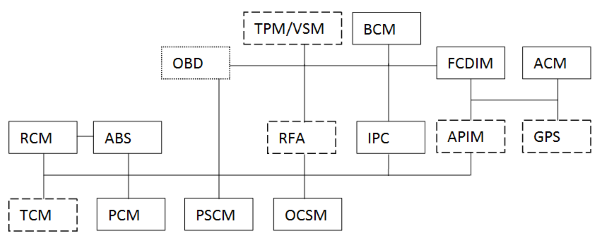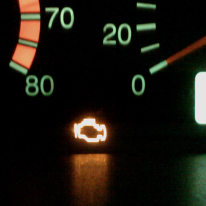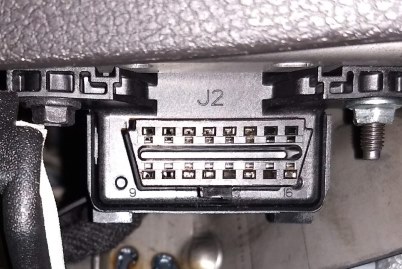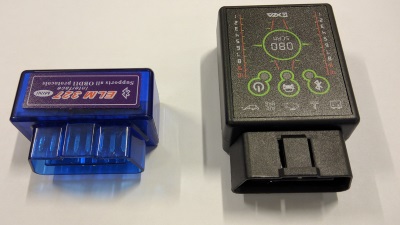What is an ECU?
If you see an error light on your car dashboard the servicing technician may mention an ECU. What does ECU stand for in cars? The acronym ECU stands for Electronic Control Unit. An ECU is an embedded (hidden) computer that controls part of a vehicle's functionality. Although an ECU is a computer it does not look like a laptop computer with screen and keyboard. Instead of a keyboard an ECU has sensors and signals from other parts of the car as the input. The ECU outputs are signals for lights, actuators and other ECUs. No screen or monitor, though some ECUs control the vehicle dashboard, gauges and radio. Here is a picture of an ECU that was removed from a car, this one was used to control the car's airbag. The metal case protects the delicate computer inside.

A Brief History of the ECU
Air pollution in major cities was becoming a big problem in the mid-20th century (and is still a problem in some of the world's cities). In the United States of America (USA) the federal government introduced the Clean Air Act to reduce emissions of pollutants, including exhaust emissions from cars and vehicles (known as the mobile sources). This forced car manufacturers to accelerate the adoption of electronic control of car engines in an effort to produce a better fuel burn. A better burn of fuel means less waste products being emitted from the vehicles exhaust. At first this new electronic device to manage engine ignition was sometimes called an Engine Control Unit (ECU).
Engine Control Units, the First ECUs
These first ECU's were crude by today's standards, using hard coded lookup tables held in Read Only Memory (ROM) chips. Hard coded values had to be used due to the processing speed limitations of the early microprocessors and digital electronics. Car enthusiasts and race technicians would perform an ECU remap by changing the ROM chips. What is an ECU remap? The values in the ECU ROM would be "remapped" to new (hopefully better performing) values, in order to improve the performance of an engine (usually power output). This spawned the ongoing ECU chipping industry in the 1980's and 1990's. ECU chipping involves changing the stored software or data (also known as a reflash), or replacing the chips containing it. An ECU reflash was the first example of vehicle computer hacking. A video of a talk, given in 2007, on hacking engine ECUs can be seen on YouTube.
From Engine Control to Electronic Control
As digital electronics improved vehicle manufacturers began adding more microprocessor controlled features to vehicles: alarms, central locking and more. The amount of electronics on a vehicle increased and the meaning of ECU changed from Engine Control Unit to Electronic Control Unit, as ECUs controlled other vehicle functions. Today the engine specific ECU will be referred to as the Engine Management System (EMS). Similarly other ECUs in a vehicle will have other designations related to their function. For example the Transmission Control Module (PCM) may refer to an ECU that monitors and controls an automatic gearbox. Likewise the Anti-lock Braking System (ABS) ECU stops the wheels locking up under heavy braking.
Occasionally an ECU will be referred to as an on board unit (OBU). However, OBUs are usually after market devices or transponders added to vehicles for additional functionality. For example OBUs are used for automatic toll charging or fleet management telematics. Another name for an ECU is an electronic control module (ECM), though ECU is the most common English term.
The Controller Area Network Addresses Wiring Complexity
The new electrical and electronic features being added to cars saw a large increase in the about of cabling in vehicles, adding weight and complexity. In the 1980's Robert Bosch GmbH developed the Controller Area Network (CAN) to provide a two wire data interface between the increasing number of electronic modules in a vehicle. The two wire CAN signalling reduces the amount of cabling required in a vehicle. Instead of one wire for each signal between modules, the signals are multiplexed (shared) on a two wire digital network. Here's a schematic for the ECU CAN network for a Mark 6 Ford Fiesta, dashed boxes are for vehicle options.

- ABS - Anti-lock Braking System
- ACM - Air Conditioning Module
- APIM - Accessory Protocol Interface Module
- BCM - Body Control Module
- FCDIM - Front Control Display Interface Module
- GPS - Global Positioning System
- IPC - Instrument Panel Cluster
- OBD - On-board Diagnostics port
- OCSM - Occupant Classification System Module
- PCM - Powertrain Control Module
- PSCM - Power Steering Control Module
- RCM - Restraint Control Module
- RFA - Remote Function Actuator
- TCM - Transmission Control Module
- TPM/VSM - Tire Pressure Monitoring/Vehicle Security Module
Increasing Vehicle Complexity
Modern vehicles are highly dependent upon ECUs and the in-vehicle networks that connect them. This dependence is increasing as technology advances. The cost and execution speed of the microprocessors, and the improvements in sensor abilities allows additional functions to be added to a car. These functions include advance driver assistance systems (ADAS) and linking to smartphone applications (apps). The digital networks connecting the ECUs need to handle faster data rates. This means the CAN bus is not the only network used in a car. Other networks can include FlexRay, Media Oriented System Transport (MOST) and automotive Ethernet.
Vehicles have effectively become mobile supercomputers, especially true of connected autonomous vehicles (CAV), a.k.a the self-driving car or robocar. In these robocars powerful computers do the driving, after analysing the signals from radar, cameras and other sensors. The robocars are the most complex of the vehicles on the road, however, the advances in technology will continue and therefore this complexity will increase.
ECU Diagnostics
An ECU is a machine, it may not have any mechanical parts but it is still built of electronic components through which electrical signals flow. All components have a lifespan and can contain manufacturing or installation faults. Therefore ECUs can, and do, fail or develop faults. As do the sensors that connect to them. Many ECUs contain diagnostics software to detect vehicle or sensor faults. ECU self-diagnostic abilities are also present. The software in the ECU will check itself for faults. When a car or ECU fault is detected a warning light will be displayed on the car's dashboard or dials.

Picture derived from a Public Domain Wikimedia Commons image by .kkursor
The fault warning light is known as a Malfunction Indicator Light, or simply a MIL light. Sometimes the MIL light will be intermittent, sometimes on, sometimes off. An intermittent light can be due to loose or dirty connectors or sensors, worn insulation on wiring, or some other problem developing. A MIL light will require booking the car into a service centre so that the problem can be diagnosed. Since a car is highly computerised, it will need a computer to help find the problem.
On-board Diagnostics Port
All cars have a port for plugging in diagnostics equipment. It is called the On-board Diagnostics (ODB) port. Originally designed for officials to check the emission control systems in vehicles it has become a common way to access the internal car networks. The ODB port is normally located close to the steering wheel. If not visible below the steering wheel it may be behind a small panel or an ashtray.

ODB port, image CC-BY-SA-3.0 from Wikimedia Commons by M.Minderhoud
A garage technician will plug a diagnostic computer into the ODB port to retrieve and display the internal ECU settings and diagnostics values. These are known as vehicle parameter identifiers, or simply PIDs. Some PIDs are defined by standards, others will be specific to a manufacture and their car models. Once a fault has been fixed the PID can be reset by the diagnostics computer.
Accessing and Resetting PID Codes to Clear MIL Lights
For the home repairer the garage equipment can be very expensive to buy. Fortunately there are cheaper solutions. Equipment can be hired, freelance auto technicians can be hired for a diagnostics or PID reset session, and finally there are low lost OBD interfaces. Here is picture of two low cost interfaces for the OBD port.

These interfaces come in Bluetooth, Wifi and USB versions. They allow computers, tablets and laptops to connect to the OBD port. Software and apps, for example the Torque OBD App, can read the cars data and diagnostic information. These apps also allow car enthusiasts to have fancy displays of performance data on a smartphone or tablet. Some of these apps will allow the PID codes to be cleared. Saving the home mechanic money. However, the cheaper ODB interfaces are of poor quality and may not always work properly, it is worth paying a little more to get a reliable OBD interface.
Car Software Updates
With so many computers in a modern car the possibility of a software bug being present is high. When a bug needs fixing the software in the ECU will need updating. This can be done through the OBD port at a garage, or sometimes by plugging a USB stick into the car's media player. However, increasingly car software is updated over the mobile phone network. Many modern cars are now fitted with cellphone connections to the manufacturers' servers, to allow for Over-The-Air (OTA) updates to car software.
The Constant Change in Automotive Technology
The constant innovation in technology and high levels of market competition in the automotive industry means there is constant change. The move to electric vehicles and wireless interfaces means that the OBD port will become redundant. Electric vehicles do not need emissions testing, and vehicle manufacturers are using wifi and cellphone connections to connect diagnostic equipment to cars. What this means for future home mechanics is to be determined.
See Also
- Since computers control cars, and computers can be hacked, so can cars. See a list of car hacking videos on YouTube.
- For information on CAN wiring and wiring OBD ports see the article CAN Bus Wiring Diagram, a Basics Tutorial.
- For a full list of all the articles in Tek Eye see the full site Index.
Comments
Celtic Latins on 1st July 2022 at 16:20 said: Thank you for explaining very well.
Author:Daniel S. Fowler Published: Updated:







